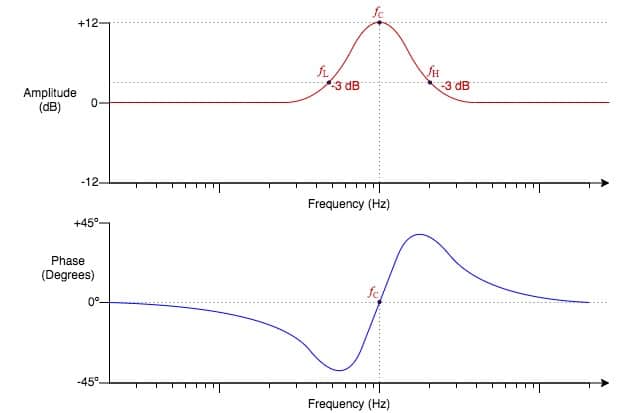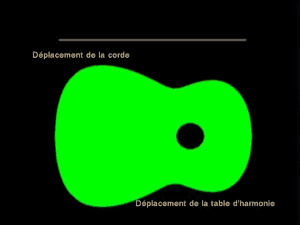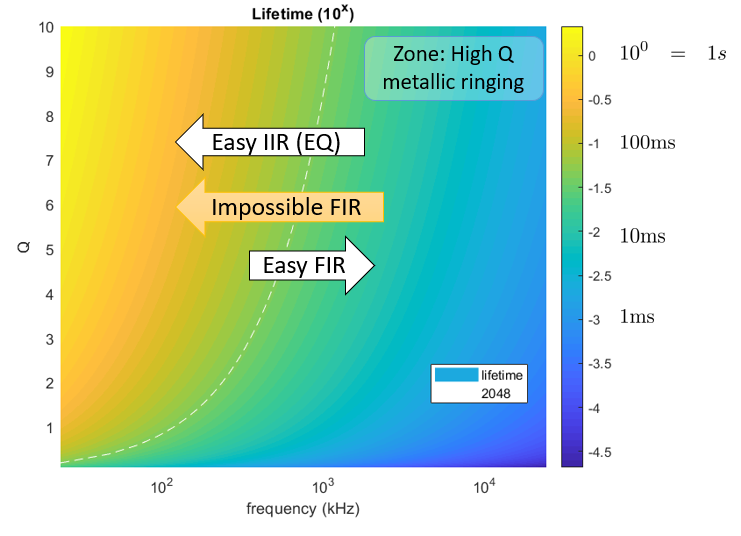
 |
|
#1
|
|||
|
|||
|
I've been watching a bit recently on IR loader pedals, and it from my (admittedly limited) understanding, is an IR convolve basically a complex, reversed engineered EQ?
This also led me to look into EQ matching, and as a Reaper user, I came across this free JS plugin "Spectrum Matcher", so I did some quick tests and as far as I can tell this is what it is doing - the down side for me is not having a decent mic and recording setup. I was wondering if those who know more about these things could comment.
__________________
National Resophonic NRP 12 Fret Loar LH-700-VS Archtop Eastman E8-OM Herrmann Weissenborn Recording King RP-10 Recording King RG-35-SN Lapsteel Maton 425 12-string ESP 400 series telecaster Eastman T485 Deering Americana Banjo My Youtube |
|
#2
|
|||
|
|||
|
Quote:
Let's start from the begining (math content) What is EQ? EQ is based on Infinite Impulse Response (IIR) filtering which is obtained thanks to a biquad filter. The normalized difference equation of a biquad is the following  where x[n] is the current filter input, x[n-1] is the past input from one sampling period, and x[n-2] from 2 sampling period. y[n] is the current filter output. y[n-1] is the past input from one sampling period, and y[n-2] from 2 sampling period. It means an EQ filter (Peak, shelf, Highpass...) usually needs only
It's very efficient but there is a price to pay. If you set the amplitude response you like in the frequency domain (see red curve below)... the software you are using computes the proper a and b coefficients to get the bell shape in red. The consequence is that you are not able to choose the phase response.... it is set by the math (principle of causality to be precise). The phase response is shown in blue below. the signal with slightly lower frequency with respect to your filter center frequency will thus be slighty delayed compared to the higher frequencies. It's not much but in the end it counts.  What is IR? What guitarists call IR is based on Finite Impulse Response (FIR) filtering which is obtained thanks to this difference equation  where x[n] is the current filter input, x[n-1] is the past input from one sampling period, and x[n-2] from 2 sampling period.... up to x[n-N]. y[n] is the current filter output. For a Line 6 Helix or Nux Optima Air, N=2048. It means IR convolution in these pedals needs
In this case, you have much more parameters to set and basically you can set both the amplitude and phase response of your filter in the frequency domain. It is very important because it gives you the ability to slightly delay the lows, mids, and high so the response is natural. When you pluck a string with a piezo undersaddle transducer, you hear the highs first. In reality the strings tension releases the top which vibrates on its main modes in the 100-500Hz range. (see image below, where the oscillation starts in the center of the top and then spreads) [This is my personal interpretation]  However their is a cost too. Since FIR filter don't have access to past outputs they have limited resolution in the low end. Low frequencies corresponds to long period of oscillation, which means you need long IR files to accurately reproduce the low end response. Also the phase response of a long IR file can end up with a distant feel. Due to delayed response. Why that? an IIR response takes into account the past ouputs so basically it has a memory of the state of the filter. Let's say you set your frequency around 100Hz where the main mode is. If you have been playing already for a minute, the top is already moving, so the 100 Hz resonance is already full of energy. the IIR will know that and only feed or take from it accordingly. On the opposite, a FIR filter has no memory of the output, it has no idea if the 100Hz is already moving.... Basically it always assume your top is "cold". To conclude: EQ are IIR filter PROs: They are simple, efficient and have a "memory" of both the inputs and the outputs. They can do simple frequency shaping (Shelf, high-pass,low pass, bell, notches, parametric, graphic...). They are accurate all along the spectrum and enable to perform high-Q (thin peak or notches) correction. CONs: They don't let you tune the phase response (unless you choose not to alter the amplitude). IR are FIR filter PROs: They are complex. They have NO memory of the past outputs. They allow you to shape both amplitude and phase. So you can actually create microdelays between frequencies on purpose. This enables you to recreate the top response of your guitar in time. CONs: They require more computing power. They are inaccurate on the low end unless your DSP is strong enough to use bigger IR wav files. They can not perform high-Q (thin peak or notches) correction in the low end as easily as IIR. (So you will never make an anti-feedback filter out of FIR). They will induce a distant feel (which can be a bless: more natural response or a curse: roomy distant sound). What you see on the net and Youtube Many people claim making IRs by using EQ match such as Fabfilter Pro Q and then capture the response into an IR file. Is it possible? YES, however with the limitation mentioned above. You won't model the phase response of your guitar, the low end resolution will be limited, and your IR file when used will not feature the "memory" effect an IIR has. http://acousticir.free.fr/spip.php?article210 Will it be like Tonedexter? NO. Tonedexter, Optima AIR, Fishman Aura... All those pedals model BOTH amplitude AND phase. However you might like it better...
__________________
Martin 00-18V Goldplus + internal mic (2003) Martin OM-28V + HFN + internal mic (1999) Eastman E6OM (2019) Trance Audio Amulet Yamaha FGX-412 (1998) Gibson Les Paul Standard 1958 Reissue (2013) Fender Stratocaster American Vintage 1954 (2014) http://acousticir.free.fr/ Last edited by Cuki79; 02-20-2022 at 07:51 AM. |
|
#3
|
|||
|
|||
|
Oh my goodness that is quite a response! Cuki I was hoping you'd weigh as I know you have considerable expertise in this area.
Without diving too deep into the mathmatics, which is way over my head, simply speaking EQ shapes the frequencies using a curve, IR reproduces phasing but samples the whole waveform (at 2K in your examples) and can do some shaping, most IR pedals do both? I'm not sure I'm getting the "memory" part of your explanation but I'll give another couple of reads! Thanks for the extensive info, much appreciated.
__________________
National Resophonic NRP 12 Fret Loar LH-700-VS Archtop Eastman E8-OM Herrmann Weissenborn Recording King RP-10 Recording King RG-35-SN Lapsteel Maton 425 12-string ESP 400 series telecaster Eastman T485 Deering Americana Banjo My Youtube |
|
#4
|
|||
|
|||
|
Quote:
> IR reproduces phasing but samples the whole waveform (at 2K in your >examples) I am not sure to understand that sentence. I would say no. Sampling is what happens to the pickup signal. In both case, EQ or IR convolution the signal is sampled. What IR convolution does is "trig" an Impulse Response. Check that video IR convolution does shaping AND phase adjustment. It's not good at super sharp peaks or super sharp notches in the lower frequency range but overall it does the job. As far as the memory, it is quite difficult to explain on a post.
__________________
Martin 00-18V Goldplus + internal mic (2003) Martin OM-28V + HFN + internal mic (1999) Eastman E6OM (2019) Trance Audio Amulet Yamaha FGX-412 (1998) Gibson Les Paul Standard 1958 Reissue (2013) Fender Stratocaster American Vintage 1954 (2014) http://acousticir.free.fr/ Last edited by Cuki79; 02-20-2022 at 07:55 AM. |
|
#5
|
|||
|
|||
|
Hazmuz kindly pointed to me a typo in my original response
I wrote IIR instead of FIR. "What guitarists call IR is based on Finite Impulse Response (IIR=>FIR) filtering which is obtained thanks to this difference equation" what we call EQ is based on Infinite Impulse Response filters (IIR) what we call IR is based on Finite Impulse Response filters (FIR)
__________________
Martin 00-18V Goldplus + internal mic (2003) Martin OM-28V + HFN + internal mic (1999) Eastman E6OM (2019) Trance Audio Amulet Yamaha FGX-412 (1998) Gibson Les Paul Standard 1958 Reissue (2013) Fender Stratocaster American Vintage 1954 (2014) http://acousticir.free.fr/ |
|
#6
|
|||
|
|||
|
Here is a map I made for myself to make preset on the Line 6 HX plateform
Let's consider you need to add a peak in frequency. You would use a parametric EQ. The sharper the EQ peak, the more it "rings" in time domain. I call the ringing time: "lifetime". Here I report the "lifetime" (color) with respect of peak frequency and Q-factor. if your FIR is 2048 pts long (ex: Line 6) it is equivalent to a maximum of 42ms response. It means you can not make a parametric EQ correction that would ring longer than 42 ms (color is around green). This limit is highlighted by the dashed white line. Making a parametric EQ on the right of that line will be easy to handle by a 2048pts FIR. Making a parametric EQ on the left of that line is impossible with a 2048 pts FIR. For example, if you want to add a peak at 120 Hz with a Q-factor of 10 to account for the main mode you'd rather use an IIR filter (EQ). I did not find that by myself, Larry Fishman wrote it in Premier guitar (look for biquad): https://www.premierguitar.com/acoust...digital-divide. So if you are using a Helix/HX pedal with good EQ capablities, you'd better do like Fishman and let an EQ this part of the job. That's what I do in my "Dry" preset.  Everything on the right side of this dashed line can be easily handle by a FIR filter. (the IR wav file)
__________________
Martin 00-18V Goldplus + internal mic (2003) Martin OM-28V + HFN + internal mic (1999) Eastman E6OM (2019) Trance Audio Amulet Yamaha FGX-412 (1998) Gibson Les Paul Standard 1958 Reissue (2013) Fender Stratocaster American Vintage 1954 (2014) http://acousticir.free.fr/ |
|
#7
|
|||
|
|||
|
Quote:
Most pedal could do it easily but they are not usually programmed to. That's why I like the Line 6 HX stomp, it is very flexible.
__________________
Martin 00-18V Goldplus + internal mic (2003) Martin OM-28V + HFN + internal mic (1999) Eastman E6OM (2019) Trance Audio Amulet Yamaha FGX-412 (1998) Gibson Les Paul Standard 1958 Reissue (2013) Fender Stratocaster American Vintage 1954 (2014) http://acousticir.free.fr/ |
|
#8
|
||||
|
||||
|
Quote:
I use a ToneDexter (for 2˝ yrs now), and know what is written about how IRs work. Mine sounds amazing when I play it live, but I've concluded it's based on fairy-dust mixed with cutting-edge-magic. IRs are allegedly able to make my great guitar sound more natural through an amp or PA. In my case it does just that, and I've never been able to match that using high end preamps and EQs. |
|
#9
|
|||
|
|||
|
Thanks Cuki for the detailed(!) responses. Much of it is over my head but I do have a better understanding of how it works and the differences. I'll take my time and I'll be coming back to this breakdown frequently.
Thanks ljguitar to for your input, too!
__________________
National Resophonic NRP 12 Fret Loar LH-700-VS Archtop Eastman E8-OM Herrmann Weissenborn Recording King RP-10 Recording King RG-35-SN Lapsteel Maton 425 12-string ESP 400 series telecaster Eastman T485 Deering Americana Banjo My Youtube |
|
#10
|
|||
|
|||
|
You can use IR files in Reaper. I believe its Reaverb that you can load the IR file. There are some free acoustic IR files on the internet
http://acousticir.free.fr/spip.php?i...=rubrique&mots[ |
|
#11
|
|||
|
|||
|
As I do my deep dive into IRs, I rediscovered this thread. It still doesn’t make sense to me, but at least it makes sense to some of you.
What I do know is that my best guitar and pickups sound a heck of a lot better through this math, and that the best analog chain can’t even come close. |